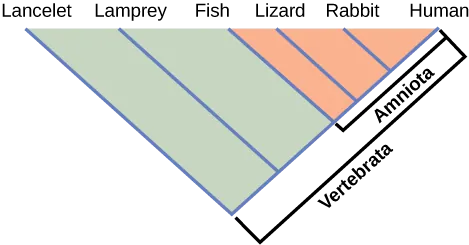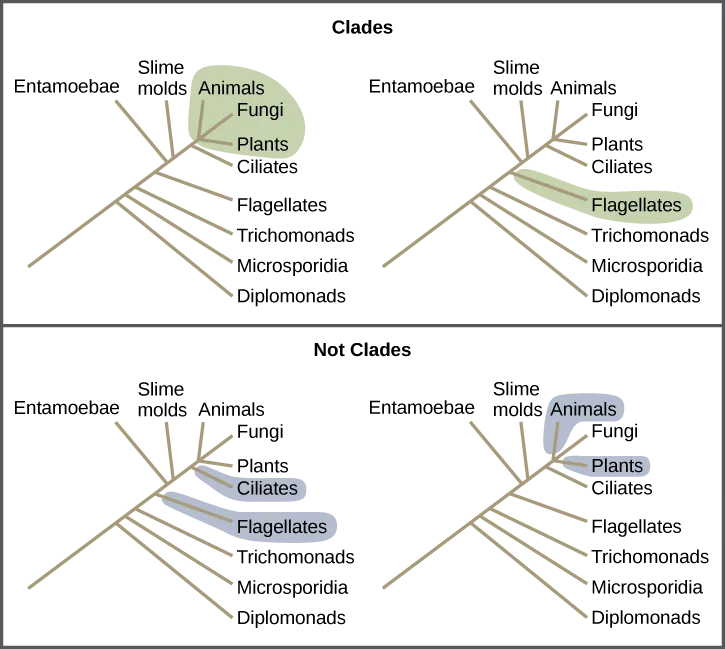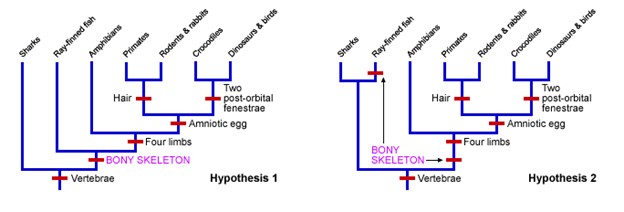Reconstructing Evolutionary Relationships
Section Goals
By the end of this section, you will be able to do the following:
- Distinguish between ancestral and derived characters
- Make inferences and predictions based on the patterns depicted in phylogenies
- Explain the principle of parsimony as it relates to phylogenies
How do scientists construct phylogenetic trees? After they sort the homologous and analogous traits, scientists often organize the homologous traits using cladistics. This system sorts organisms into clades: groups of organisms that descended from a single ancestor. For example, in Figure 1, all the organisms in the orange region evolved from a single ancestor that had amniotic eggs. Consequently, these organisms also have amniotic eggs and make a single clade, or a monophyletic group. Clades must include all descendants from a branch point.
The monophyletic group is the “ideal” type of cladogram because it will contain the ancestor and every single descendant species. There are no missing species and no gaps. Every piece of the puzzle is present.

Which animals in this figure belong to a clade that includes animals with hair? Which evolved first, hair or the amniotic egg?
Answer:
The largest clade encompasses the entire tree.
Clades can vary in size depending on which branch point one references. The important factor is that all organisms in the clade or monophyletic group stem from a single point on the tree. You can remember this because monophyletic breaks down into “mono,” meaning one, and “phyletic,” meaning evolutionary relationship. Figure 2 shows various clade examples. Notice how each clade comes from a single point; whereas, the non-clade groups show branches that do not share a single point.

What is the largest clade in this diagram?
Answer:
Rabbits and humans belong in the clade that includes animals with hair. The amniotic egg evolved before hair because the Amniota clade is larger than the clade that encompasses animals with hair.
Shared Characteristics
Organisms evolve from common ancestors and then diversify. Scientists use the phrase “descent with modification” because even though related organisms have many of the same characteristics and genetic codes, changes occur. This pattern repeats as one goes through the phylogenetic tree of life:
- A change in an organism’s genetic makeup leads to a new trait that becomes prevalent in the group.
- Many organisms descend from this point and have this trait.
- New variations continue to arise: some are adaptive and persist, leading to new traits.
- With new traits, a new branch point is determined (go back to step 1 and repeat).
If a characteristic is found in the ancestor of a group, it is considered a shared ancestral character because all of the organisms in the taxon or clade have that trait. The vertebra in Figure 1 is a shared ancestral character. Now consider the amniotic egg characteristic in the same figure. Only some of the organisms in Figure 1 have this trait, and to those that do, it is called a shared derived character because this trait was derived at some point but does not include all of the ancestors in the tree.
The tricky aspect of shared ancestral and shared derived characters is that these terms are relative. We can consider the same trait one or the other depending on the particular diagram that we use. Returning to Figure 1, note that the amniotic egg is a shared ancestral character for lizards, rabbits, and humans while having hair is a shared derived character only for humans and rabbits. For the Amniotes as a group, however, the amniotic egg is a shared derived character that is not seen in fish. These terms help scientists distinguish between clades in building phylogenetic trees.
Did I Get It?
Choosing the Right Relationships
Organizing the evolutionary relationships of all life on Earth is difficult. Scientists must span enormous blocks of time and work with information from long-extinct organisms. Trying to decipher the proper connections, especially given the presence of homologies and analogies, makes the task of building an accurate tree of life extraordinarily difficult. Add to that advancing DNA technology, which now provides large quantities of genetic sequences for researchers to use and analyze. Taxonomy, the branch of science concerned with the classification of organisms, is a subjective discipline in some ways: many organisms have more than one connection to each other, so each taxonomist will decide the order of connections. These relationships can change as more data is gathered and technology changes to highlight previously unknown information.
To aid in the tremendous task of describing phylogenies accurately, scientists often use the concept of maximum parsimony, which means that events occurred in the simplest, most obvious way. For example, if a group of people entered a forest preserve to hike, based on the principle of maximum parsimony, one could predict that most would hike on established trails rather than forge new ones.
For scientists deciphering evolutionary pathways, the same idea is used: the pathway of evolution probably includes the fewest major events that coincide with the evidence at hand. Starting with all of the homologous traits in a group of organisms, scientists look for the most obvious and simple order of evolutionary events that led to the occurrence of those traits.
In the following example, notice two evolutionary trees were created, representing Hypothesis 1 and Hypothesis 2 (Figure 3). Notice that Hypothesis 1 shows 6 novel changes indicated by the red bars. Hypothesis 2 shows 7 changes. Based on maximum parsimony, the better hypothesis to describe the relationship between these species would be Hypothesis 1.

Head to the Using parsimony page from Understanding Evolution to learn how this principle is used to construct phylogenetic trees.
These tools and concepts are only a few of the strategies scientists use to tackle the task of revealing the evolutionary history of life on Earth. Recently, newer technologies have uncovered surprising discoveries with unexpected relationships, such as the fact that people seem to be more closely related to fungi than fungi are to plants. Sounds unbelievable? As the information about DNA sequences grows, scientists will become closer to mapping the evolutionary history of all life on Earth.
Did I Get It?
CC Licensed Content, Shared Previously, Included in Evolutionary Patterns
- Biology 2e. Authors: Mary Ann Clark, Matthew Douglas and Jung Choi. Provided by: OpenStax CNX. Located at: Biology 2e. License: CC BY: Attribution 4.0.
- Biology for Majors II. Authors: Shelly Carter and Monisha Scott. Provided by: Lumen Learning. Located at: Biology for Majors II | Simple Book Production. License: CC BY: Attribution 4.0.
- Introductory Biology: Ecology, Evolution, and Biodiversity Author: Erica Kosal. Provided by: Pressbooks. Located at: Introductory Biology: Ecology, Evolution, and Biodiversity – Simple Book Publishing License: CC BY-NC 4.0.

